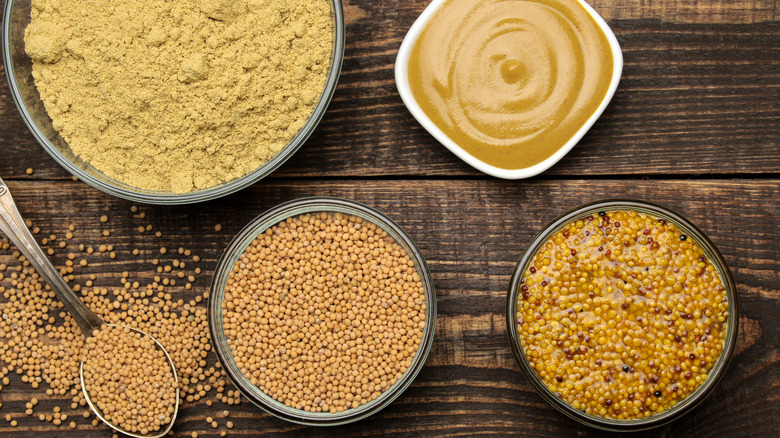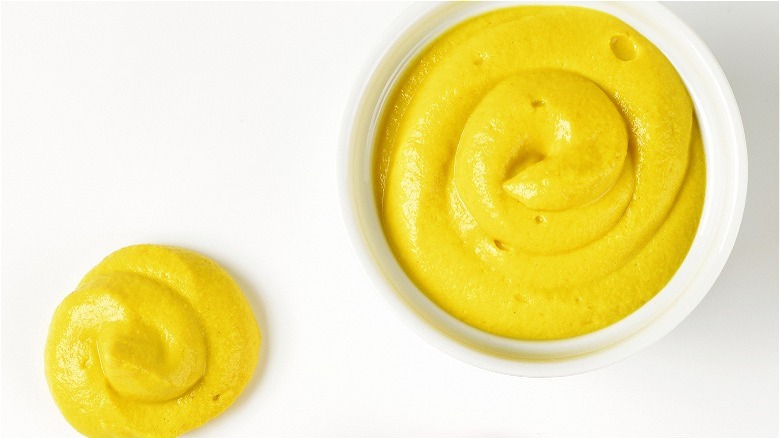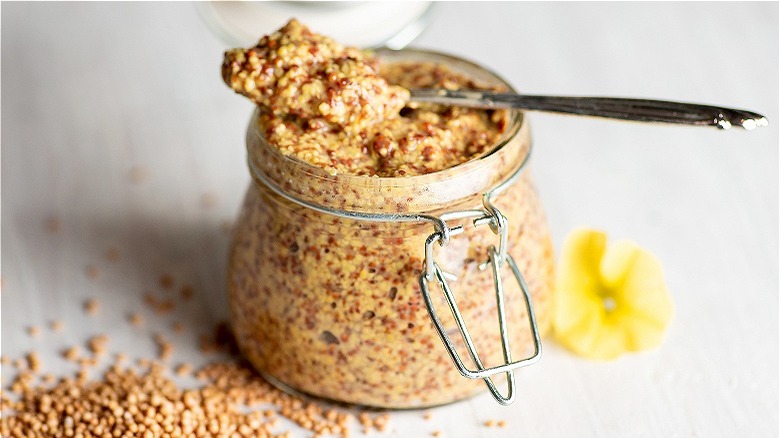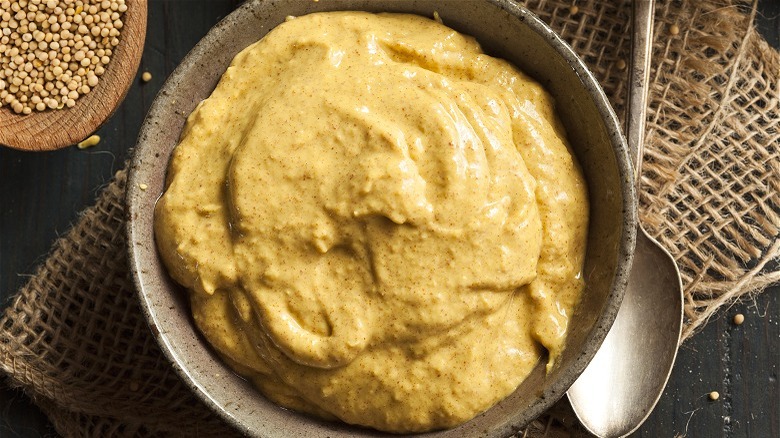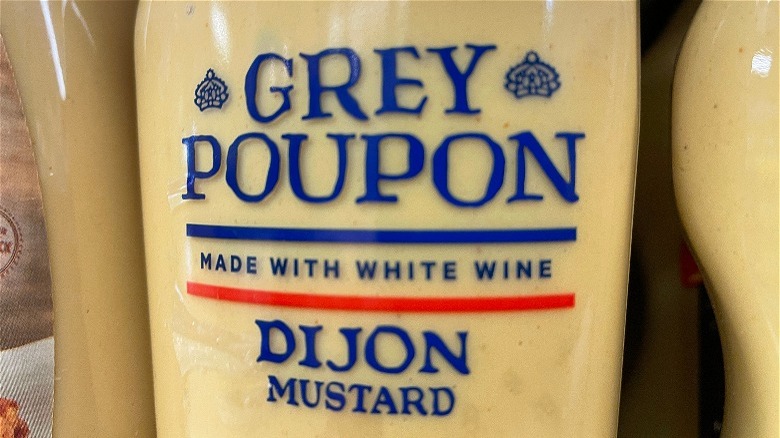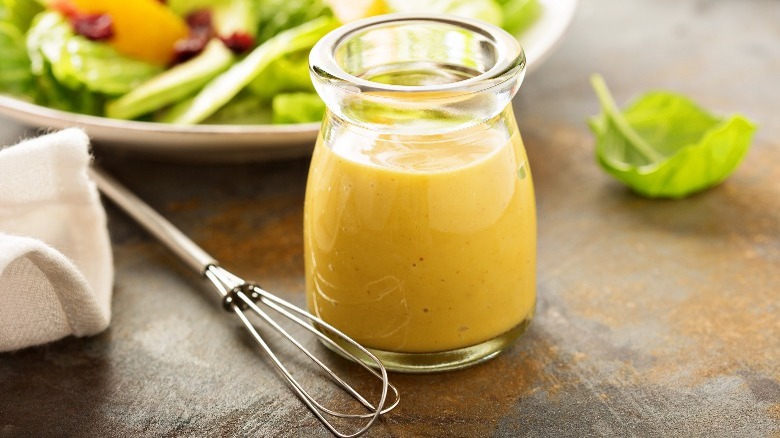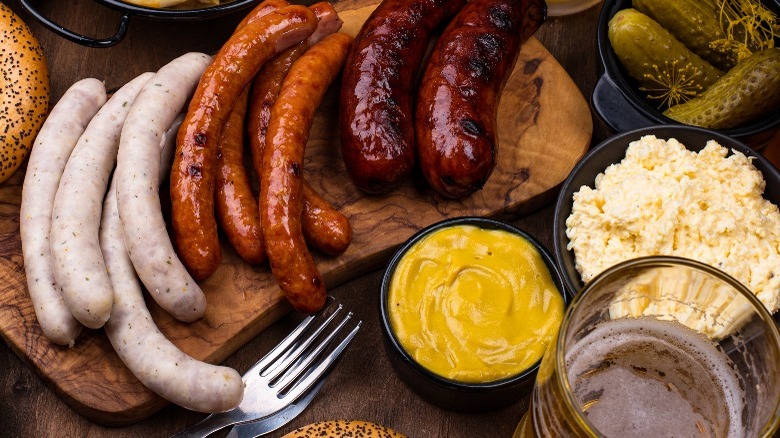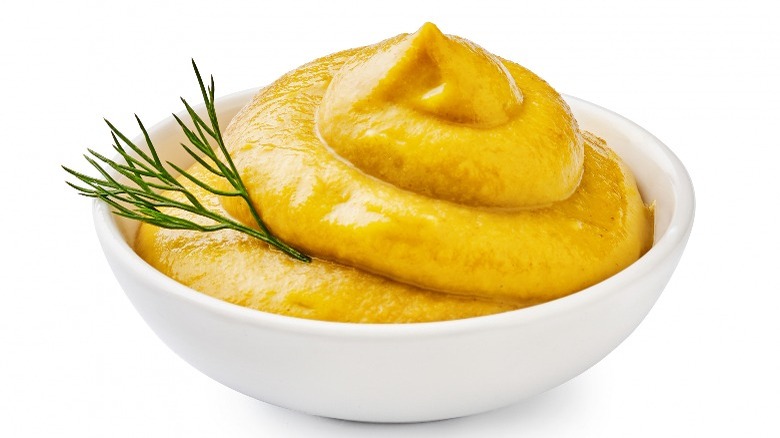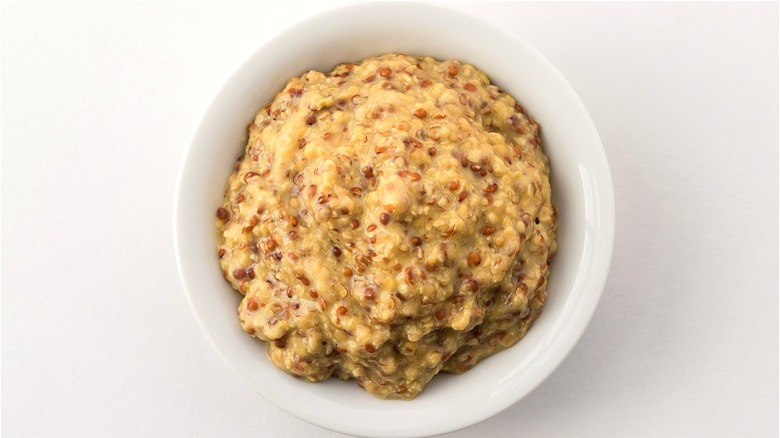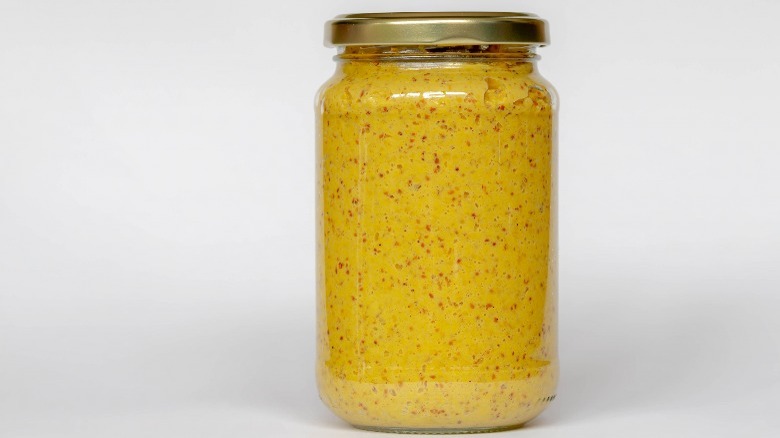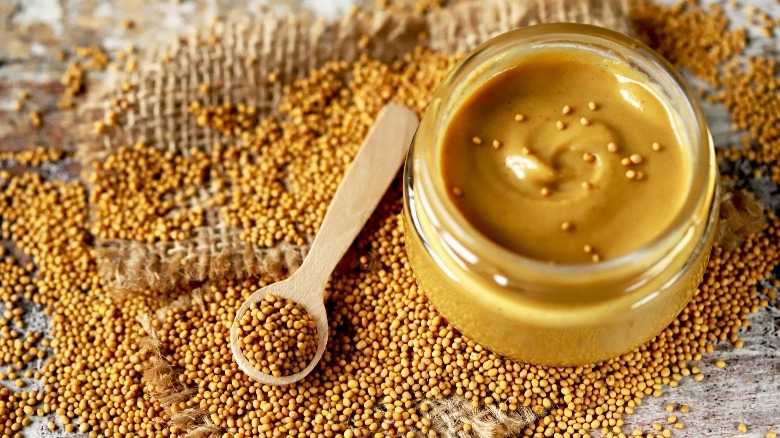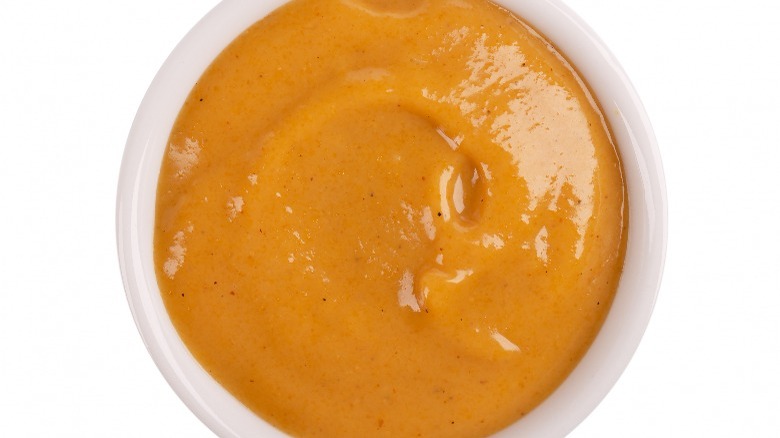The 11 Different Mustard Varieties You Should Get To Know
When it comes to condiments, mustard is a perennial favorite. According to a study published by the journal Foods, humans have been making use of the mustard plant for thousands of years, since around 3000 B.C. Whether it's spread on a cheese sandwich, slathered on a hot dog, or blended into salad dressing, mustard's bright flavor shines. This is partly because the condiment works well with so many different foods.
Mustard spread — arguably the most popular form of prepared mustard — is made from seeds of the mustard plant. Mustard falls in the Brassicaceae family, which also includes broccoli, cabbage, and cauliflower. There are around 40 species of the mustard plant. But only three are most commonly cultivated for their seeds. These are Brassica nigra (black mustard), Brassica juncea (brown mustard), and Sinapis alba (white mustard or yellow mustard).
According to Healthline, mustard is also good for you. The condiment contains nutrients like iron, calcium, phosphorus, and selenium. Mustard also contains flavonoid antioxidants. These compounds may protect against cancer, heart disease, and Type 2 diabetes, as well as help fight bacterial and fungal infections. With these potential health benefits in mind, we should all be looking for more ways to incorporate mustard into our diets. Luckily, there is an almost dizzying array of mustard choices available. Here are 11 different mustard varieties you should definitely get to know.
Yellow mustard
When you think of mustard, yellow mustard is probably what comes to mind. According to a study published in the journal Foods, this American classic is made by pureeing white mustard seeds with vinegar and turmeric — a spice that gives the condiment its distinctive yellow color. Yellow mustard has a perfectly smooth consistency. The white mustard seeds contain unique scientific compounds that give the condiment a bright flavor. However, yellow mustard is still pretty mild, compared to other mustard varieties.
Yellow mustard is a pantry staple. It's perfect for spreading on any sandwich, whether there is turkey or roast beef between those slices of bread. Of course, no barbecue is complete without yellow mustard for your hot dogs and hamburgers. But yellow mustard isn't just for meat. Its mild yet tangy flavor is perfect for making cocktails, such as a Bloody Mary. Made with tomato juice, olives, and pickled vegetables, it's practically a salad in a glass.
Whole grain mustard
True mustard fans will love whole grain mustard, with its rustic flavor and gritty texture. As the name suggests, whole grain mustard is made from mostly unblended mustard seeds. With their shape kept mostly intact, this condiment is less smooth than yellow mustard. There is a wide variety of whole grain mustards out there. But most are made using a combination of black and brown mustard seeds, which are partially crushed to release their bold flavor.
Because whole grain mustard has a strong flavor and texture, it pairs well with other bold foods. Use this condiment with a hearty roast beef sandwich. In this application, whole grain mustard works well because it stands up to other intense flavors. It can also be used to make a delicious sausage supper. This recipe's base consists of sausage, cabbage, and kale. Additional flavor is provided by sauerkraut, garlic, and horseradish.
Spicy brown mustard
Spicy brown mustard has a taste that's less intense than whole-grain mustard, in terms of texture and flavor. This type of mustard is typically made from brown mustard seeds, vinegar, salt, and water. These ingredients are combined, using a device such as a blender. Blending gives this mustard a mostly smooth consistency, while retaining a strong flavor that is perfect for sandwiches.
But don't stop at sandwiches. Spicy brown mustard is great in savory dishes. Use it to flavor bland potato salad. Start with a dressing made from equal parts spicy brown mustard and mayonnaise, then add this dressing to cooked potato chunks. If you like, you can add chopped apple, celery, and red onion to your potato salad as well. This adds a nice crunch. You can also use spicy brown mustard to make a shrimp po'boy sandwich. This condiment helps to add brightness to the entire dish.
Dijon mustard
For many of us, our first introduction to Dijon mustard came from watching Grey Poupon commercials. But there's more to this mustard than Grey Poupon. Dijon mustard has a rich flavor that makes it the perfect addition to many savory dishes. Dijon — named after the city of Dijon, France where it was invented — is made from brown mustard seeds. Like other mustard varieties, it contains vinegar, but it gets its distinct flavor from white wine. This combination creates a flavor profile that pairs well with most meats.
For this reason, Dijon mustard is often used to make marinades and glazes. For example, it's used in this rum-glazed ham recipe. When mixed in, Dijon mustard balances out the sweetness of the glaze. You can also use Dijon mustard to marinate pork, chicken, or even a leg of lamb before grilling. You can even spice up your brunch by adding Dijon mustard to hollandaise sauce. This iconic condiment is used in dishes like eggs Benedict.
Honey mustard
Honey mustard is one of the most popular types of commercially-prepared mustard. There are many versions of this condiment out there. Sweetness will vary from brand to brand, but all versions of honey mustard will contain at least a little bit of sweetness. The honey balances out the sharp heat of the mustard seeds, which makes this a favorite for children.
Like most mustards, honey mustard works on just about any sandwich. But it also works well in salad dressing. Making your own honey mustard vinaigrette is quick, easy, and delicious. Simply whisk together honey mustard, olive oil, and vinegar. This dressing works well with salad ingredients like field greens, roasted beets, and red onion. Additional ingredients like apples, pears, walnuts, or pecans add texture to this salad. Honey mustard also works great as a dipping sauce. Adults and children alike will enjoy dipping chicken, tofu, and even roasted veggies in this mildly sweet sauce.
German mustard
There are many varieties of German mustard which vary in sweetness and spiciness. There is Sweet Bavarian mustard, which is made from a combination of yellow and brown mustard seeds, as well as ingredients like apple cider vinegar, brown sugar, and spices. There is German whole grain mustard, which is less sweet and more savory than the aforementioned mustard. It can be made from ingredients like mustard seeds, vinegar, sugar, white wine, and salt. There is also a condiment called Bavarian beer mustard. Completely lacking in sweetness, this mustard is made by first soaking mustard seeds in a dark beer. Afterward, the soaked seeds are blended with ingredients like vinegar, brown sugar, and salt.
These condiments work great with classic German dishes like Bavarian pretzels or bratwurst. You can find these types of German mustard at major grocery retailers or online. Feel free to try a few different types of German mustard in order to find your favorite.
Dill mustard
Dill is an ingredient often used to flavor foods, both as an herb and a spice. It is both visually stunning, as well as versatile. Dill pairs well with potatoes, fish, and chicken. Plus, dill is good for you. According to Healthline, nutrients found in dill can help to reduce inflammation, prevent diseases like cancer, and lower blood sugar levels.
You can buy dill mustard prepared, but be aware that some versions contain wheat. People with celiac disease or gluten sensitivity should check the label before buying a jar of dill mustard. On the other hand, you could make your own version. Simply blend together ingredients like Dijon mustard, dill, honey, olive oil, and apple cider vinegar.
Dill mustard is perfect for adding to potato salad, spreading on a chicken sandwich, or using it as a base for dipping sauces. You can even use dill mustard to make a creamy sauce, by combining it with some sour cream. Thanks to the addition of herbs like dill, this sauce has a fresh flavor to it.
Stone-ground mustard
Stone-ground mustard has been around for hundreds of years. Historically, this condiment was made by grinding mustard seeds with a stone, using devices called a quern or millstone. The more rustic grinding process fully crushes some mustard seeds, while leaving others intact. Today, it may not always be made using ancient processes, but stone-ground mustard still has a somewhat gritty texture.
This condiment pairs well with meat, cheese, bread, and vegetables. As such, you can use stone-ground mustard in many applications. It works on a cheese sandwich, slathered on some ham, in salad dressings, or as part of dipping sauces. You can also use this condiment in savory main courses, such as this honey mustard slow cooker chicken. This recipe uses both stone-ground mustard and honey, creating a balance of heat and sweetness. As you're diving into the world of mustard, you might want to give stone-ground mustard a try.
Horseradish mustard
Spicy food lovers should get to know horseradish mustard, as this condiment definitely comes with a kick. Horseradish is a root vegetable that is related to foods like mustard, cabbage, wasabi, kale, and broccoli. According to Healthline, horseradish has anticancer and antibacterial properties. Eating it may also help improve one's respiratory health.
Horseradish alone is strong and spicy. Because of this, grated horseradish root is often combined with another food, for balance. Horseradish sauce is one popular example of this. This condiment usually relies on mayonnaise or sour cream to temper the heat. Unfortunately, this creamy condiment isn't the healthiest. But luckily, there is horseradish mustard, a healthier alternative that contains less fat and calories.
This type of mustard is great in many different recipes. It's perfect with a ham sandwich made using rustic bread slices. For a fun and easy appetizer, try this dijon horseradish roast beef crostini. It consists of horseradish mustard, deli roast beef, and rye bread. You can throw this boldly-flavored recipe together in just a few minutes.
Sweet and hot mustard
This condiment has the best of both worlds. If you like horseradish mustard and honey mustard, you'll love this spread. Surprisingly, sweet and hot mustard does not contain extra spicy ingredients like horseradish, as the heat from mustard is usually enough.
Sweet and hot mustard can be made from mustard powder, granulated sugar, rice wine vinegar, white wine vinegar, and eggs. Using sugar instead of honey gives it a different sweetness than honey mustard. Additionally, using mustard powder instead of mustard seeds provides it with a smooth texture. Because of the inclusion of rice wine vinegar — an ingredient commonly used in Asian cuisines — this mustard pairs well with Chinese food dishes such as egg rolls or spring rolls. This condiment is also delicious with roasted vegetables or potatoes.
Unlike other mustard varieties, sweet and hot mustard contains eggs. As such, sweet and hot mustard may not be suitable for vegans or people with an egg allergy. We recommend checking the ingredients listed on a product before consuming prepared sweet and hot mustard. If not, you can always make your own.
Ghost pepper mustard
The ghost pepper is one of the spiciest peppers on the planet. It contains around 1 million Scoville Heat Units. Also known as SHU, this metric is what's used to measure the heat level of different peppers. Compare that to a jalapeño pepper — which contains around 8,000 SHU — or a habanero pepper — which contains around 350,000 SHU. The ghost pepper was even ranked the spiciest pepper in the world. That was up until 2007, when it was replaced by a pepper called the Carolina Reaper. Ghost peppers are still extremely spicy, even if they aren't the hottest in the world.
Even if spicy mustard is the sort of thing you like, you might be pushing your limits with ghost pepper mustard. This condiment is only for true spice lovers, as it's very hot. If you can stand the heat, there are a few ways to use it. Spread ghost pepper mustard on a pulled pork sandwich, or add a small amount to egg salad. However, if you are serving this dish to guests, warn them about how hot the ghost pepper mustard is beforehand.
